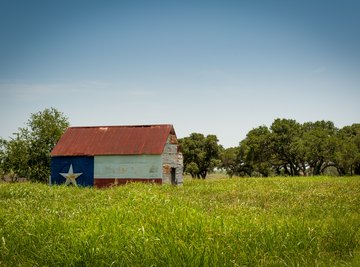
The United States' second-largest state is Texas with some 266,807 square miles. Many people may think the Texas climate is just, plain hot. But being so large, Texas actually stretches between cool and warm sections of the Northern Hemisphere’s temperature zones. Its borders are Mexico to the south, Oklahoma to its north, New Mexico to the west, and Arkansas and Louisiana to the east. Texas is known for its vast plains, grasslands, rolling hills and dessert terrains.
Type
Texas has three primary climate types: continental steppe, mountain and modified marine. The continental steppe is common in the Texas High Plains, which experiences extreme temperature ranges, low humidity and minimal rainfall. This is a semi-arid climate with mild winters. The mountain climate area has cooler temperatures and experiences irregular precipitation patterns. The modified marine climate is subtropical, including areas classified as humid, sub-humid, semi-arid and arid.
The Facts
The area of Texas is 266,807 square miles. This includes 4,790 square miles of inland waters, yet not the 7 square miles of the Gulf of Mexico’s coastal waters. Its highest elevation is Guadalupe Peak at 8,751 feet above sea level. Temperatures range from an average in July of 83 degrees F to an average in January of 46 degrees F. Annual precipitation is 27 inches.
Features
The eastern portion of Texas, which comprises about a third of the state, has a subtropical humid climate, experiencing warm summers. The central portion of Texas, comprising another third of the state, is a subtropical sub-humid climate with hot summers and arid winters. The remainder of the state includes basin and plateau regions that are a subtropical arid climate, with summertime precipitation anomalies. A subtropical steppe climate, with semi semi-arid weather conditions are found midway along the Rio Grande Valley to Pecos Valley. Higher elevations, such as Guadalupe, experience the cooler mountain climates.
Geography
Texas is situated along the Gulf of Mexico, with 367 miles of shoreline and this coastal area is susceptible to the wrath of hurricanes. In fact, one of the deadliest hurricanes in U.S. history hit the city of Galveston, Texas, in 1900 and was known as the Galveston Hurricane, claiming more than 8,000 lives.
History of
Major hurricanes, with winds in excess of 111 miles per hour have hit Texas numerous times over the past century. After the Galveston Hurricane, another passed over Velasco, Texas, in 1909, destroying half of the town. The following month a hurricane that damaged Haiti and Mexico caused significant gales along coastal Texas. In 1915 another deadly hurricane hit Galveston. Corpus Christi suffered a hurricane four years later, and another hit the Houston area in 1943. Hurricane Audrey made its way along the Texas/Louisiana border in 1957, with damages estimated around $700 million. Hurricanes continued to visit Texas with Carla in 1961, Beulah in 1967, Allen in 1980, Alicia in 1983, Gilbert in 1988 and Bret in 1999. Historically, tornadoes hit Texas more than 100 times a year. (See Resources section for more on Texas hurricane history.)
Risk Factors
Risk factors for people living in coastal Texas include hurricanes, but tornadoes can often be more damaging because of their sudden approach. More than 100 tornadoes hit Texas each year. Tornado paths from the southeast in coastal south Texas are prevalent due to the increased frequency of tornado-friendly weather patterns, such as hurricanes from the Gulf of Mexico.
Resources
About the Author
Ann Johnson has been a freelance writer since 1995. She previously served as the editor of a community magazine in Southern California and was also an active real-estate agent, specializing in commercial and residential properties. She has a Bachelor of Arts in communications from California State University, Fullerton.
